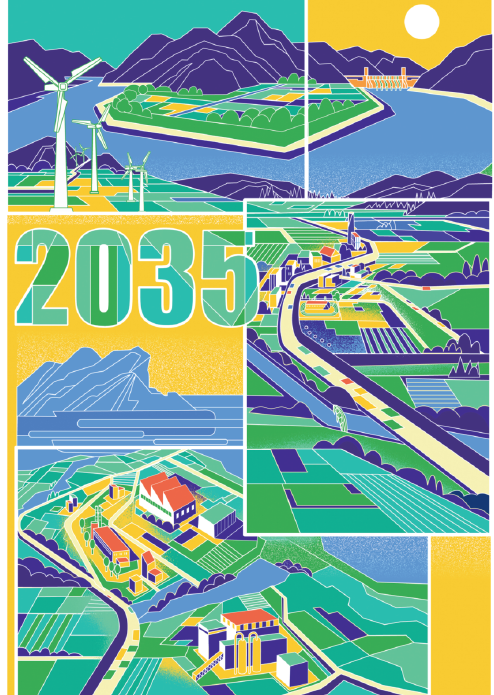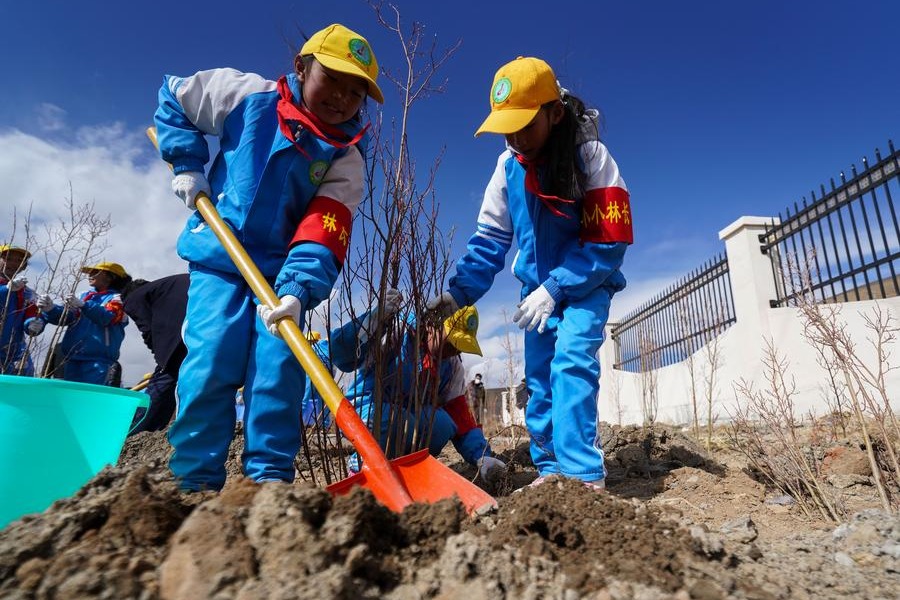Nation bracing for climate change


SHI YU/CHINA DAILY
New blueprint looks to bolster efforts to deal with global challenge
China has doubled down on efforts to build up resilience to climate change with a blueprint designed to serve as a stronger response to climate-related risks, establish heightened monitoring capacities and protect vulnerable areas and sectors.
The National Strategy on Adaptation to Climate Change, unveiled by the Ministry of Ecology and Environment and 16 other central government departments on June 13, highlighted the need to modernize national climate-related disaster prevention systems and reduce economic vulnerability in the face of mounting risk from climate change.
The policy document, which replaced a previous version issued in 2013, pledged to make parallel efforts in climate change mitigation and adaptation after China promised in 2020 to bring greenhouse gases to a peak before 2030 and become carbon neutral before 2060.
"Climate change has already had a serious adverse impact on China's environment and has continued to spread and penetrate its economy and society," the document said.
It highlighted more frequent floods, droughts, shrinking glaciers and frozen soil, as well as mounting risks to water security, increasing hazards from meteorological disasters and pests and growing health risks as a result of high temperatures and heat waves.
Climate change has also pushed China's vegetation belts northward as annual average temperatures increased by 0.26 C every 10 years between 1951 and 2020.
Chao Qingchen, head of the National Climate Center, said after the blueprint's release that climate change and extreme weather, the most significant medium- and long-term risks globally, are set to bring about heightened risks to China's economic growth and people's lives.
She cited figures showing that meteorological disasters and their aftermaths affected about 300 million people between 2000 and 2020, causing direct economic losses of 298.7 billion yuan ($44.6 billion) per year.
The latest national strategy underscored the fundamental role of monitoring and early warning for climate change and the need to bolster risk management, she said, adding that the development of a long-term, stable and consistent climate change monitoring network was also highlighted.
The document sets the target of developing a climate-resilient society by 2035 by building a nationwide system to monitor and assess climate change-related risks, and by improving the ability to prevent and control natural disasters.
It also highlighted a guiding principle for the national adaptation plan, saying that nature must be respected and proper and effective adaptation measures must be adopted based on China's socioeconomic development and its environmental and resource capacities.
The strategy also reaffirmed China's commitment to strengthening South-South cooperation with developing nations in Africa, the Pacific and other regions to help them adapt to climate change, especially in terms of agricultural production, water resource management, disaster monitoring and infrastructure development.
To build up its climate change monitoring network, China will step up monitoring of the effects of global warming on vulnerable regions, including drought-prone regions in Northwest China, as well as of water resources, vegetation and desertification in the basins of the Yangtze and Yellow rivers.
There will be an increase in early warnings against extreme weather conditions, and more accurate warnings of floods, geological disasters and forest fires.
Xu Huaqing, head of the National Center for Climate Change Strategy and International Cooperation, said in a co-authored note that the national strategy prioritizes nature, the environment, society and the economy. The plan also seeks to better regulate urban and rural environments and enable sectors like finance, energy and tourism to better adapt to climate change.
The note pointed out that inadequacies still exist in national efforts to adapt to climate change, including a lack of analysis and evaluation of its effects and risks, and added that there is a need to raise awareness and to take more action.
To make ecosystems better adapted to climate change, the strategy pledged to implement a nature-based solution, including steps to develop a monitoring system for key rivers, glaciers, frozen land and snow.
In efforts to bolster the water supply and prevent major droughts, the government will seek to extend access to tap water to 88 percent of the rural population by 2025.
Key measures to enhance the resilience of land ecosystems include expanding the coverage of nature reserves to at least 18 percent of the national land area and forest coverage to 26 percent by 2035, which would entail an increase of 23 percent over that of 2021.
The protection of marine ecosystems and the restoration of shorelines were also highlighted in the strategy, which pledged to restore 50,000 coastal wetlands and 1,200 kilometers of shoreline by 2035.
A report published by the United Nations Intergovernmental Panel on Climate Change in March said Asian coasts are projected to experience a higher rise in sea levels than the global average, with Chinese coastline megacities facing high risks of storm surges caused by tropical cyclones of higher intensity.
The report also warned against the potential harm to humans and animals as a result of rising temperatures, which could result in heat stress and mental disorders.
The national strategy pledged to effectively identify health risks and vulnerable population groups and come up with plans to better protect them.
The monitoring network and early warning capacity for climate-sensitive diseases, zoonosis (diseases that are spread from animals to humans) and other key infectious diseases as well as cardiovascular disease will be enhanced.
To make national infrastructure more resilient to climate change, the document stressed the need to develop a smart hydraulic engineering network and make energy infrastructure more capable of resisting extreme weather.
It also stressed the need to adjust the design of urban protection facilities that deal with rising sea levels and help strengthen their flood prevention capacities.
Xi Wenyi, a researcher with the China Climate and Energy Program at the World Resources Institute, said it is necessary for the country to include the adaptation to climate change in the investment, planning and development of new infrastructure, to shore up its resilience to climate risks.
"Our research has found that improving the climate resilience of infrastructure and boosting associated investment can help avert future losses and usher in benefits in terms of the economy, society and the environment," she said.
- Speaker of Zimbabwe parliament to visit China
- University punishes professor and daughter for academic misconduct
- Chinese PLA honor guard joins Minsk parade marking 80th anniversary of victory in Soviet Union's Great Patriotic War
- Xi leaves Moscow after state visit to Russia, attending Victory Day celebrations
- China eases marriage registration with new rules
- 2025 World Digital Education Conference to unveil smart education white paper





































